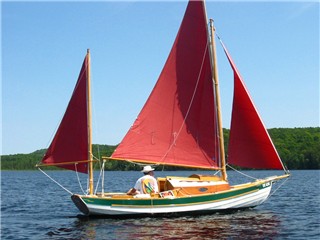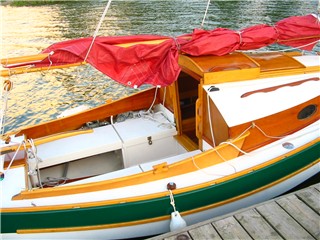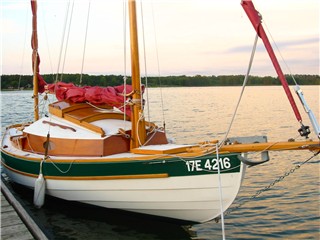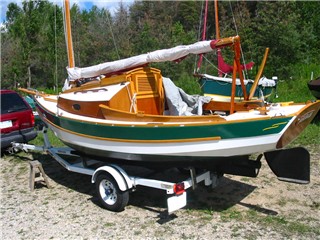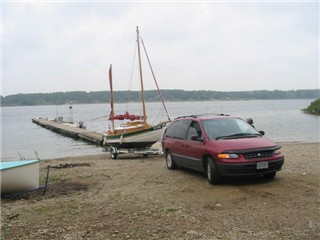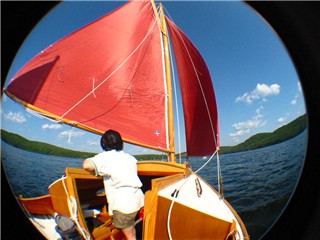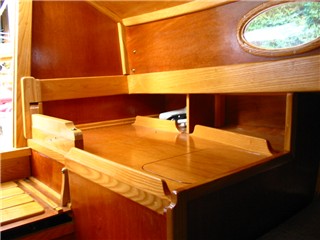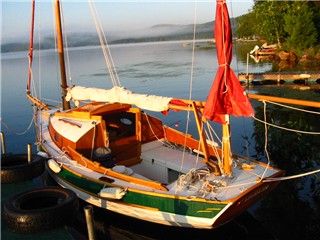Ataraxia – A Classic Sailboat of
Superior
Workmanship & Style

|
written by: Ben Ho Jan. 2004 |
|
|
Ataraxia is an 18 foot wooden sailing dory type built by boat builder Tim Cox. The hull is dory-style lapstrake construction, but uses modern materials and techniques where they will do the most good and thus is planked with mahogany marine plywood encased in epoxy and fiberglass . A bowsprit extends the overall length to slightly over 20 feet. The boat’s design is inspired by the Alden/Crocker 'Indian' Class design of 1921, which in turn was a sailing refinement of the Swampscott Dory, commonly used in New England waters as a workboat, both as row boats and fishing sailboats, and with a well established reputation for seaworthiness. Ataraxia’s design, style, and construction faithfully follow the best wooden boat techniques: Deck framing is made of spruce, and decks, cabintop, hatches, cabin sides and coaming are made of mahogany. Exterior trim is ash and mahogany, and interior is mahogany, pine and ash. Spars, hollow, are built from Sitka spruce. While keeping the traditional wood building material and workmanship, modern technology and boat building technique are applied in attempting to keep maintenance to a minimum: all woodwork is sealed in epoxy, and deck surfaces are painted in durable, anti-skid topside paint. Metal fitting are stainless, brass or bronze. Sails are in traditional Tanbark, made by professional sail loft Ullman-Fogh in Toronto. The centreboard is offset to the port side, skillfully hidden in the cockpit and galley inboard sides; it extends from mid-cabin to mid-cockpit. Gravity-dropped, the center board is easily lowered and raised from the cockpit. The beauty !of a gravity-dropped center board is that when it hits the ground, it simply rises up without resulting in any damages. Ataraxia’s yawl rig is relatively uncommon among today’s more popular fiber glass sloops, and many sailors mistakenly view it as an old fashioned arrangement. Actually, a yawl rig provides many advantages over a sloop rig. According to Alerion Yacht (a modern manufacturer of high-end sailboats), measured in terms of cruising – time reaching, running, and beating, the yawl rig is both faster and easier to handle than the sloop rig. There are well known yawl-rig sailboats of similar sizes with proven sea-worthiness and sailing performance, for example the Caledonia Yawl. One advantage of the three sail rig is that individually, each sail is smaller and easier to handle. The three- sail arrangement provides a lower center of effort and hence less heeling. In heavy winds the simplest option is to go with the ‘jib and jigger’ (jib and mizzen alone). Sailing under main alone is also an option, and typically yields a completely balance!d helm. The mizzen sail is very useful when anchoring, since it acts as a wind vane to keep the boat head to windward and reduces uncomfortable rocking motions. Another unique aspect of this boat is it’s inboard electric motor. A 24 volt electrical marine motor is built into the boat and runs off two banks of deep-cycle batteries, which are charged by an onboard charger. The batteries are designed to also act as ballast. Fully charged, the batteries have a theoretical range of at least 15 hours of driving the motor at two-thirds power, more than enough for a typical week-long sailing-camping trip. The motor control is an advanced, high efficiency type using pulse-width modulation technology which minimizes power wastage. The control console of the motor is conveniently located at the cockpit and has an integrated battery charge indicator. No more smelly, noisy gasoline motors!
|
|
|
|
|
I had the opportunity to take Ataraxia for a week-long camping trip at Elephant Lake, a beautiful lake system located at the Near North of Ontario. Connected to Baptiste Lake through a narrow but navigatable channel, the two lakes offer a total boating range of about 20 km – perfect for exploring in a small sailboat. Ataraxia was completed in 1999, and for the next several years it mostly sat in an indoor storage while the owner was relocating to south of the border. After some cleaning up and re-rigging at my local sailing club, the boat was ready to join the waves once again. The wood work still gleams, and the sails still have the vibrant rust-red color of the traditional tanbark. This beautiful boat is practically new. The five-hour drive to Elephant Lake was uneventful. The trailer is well balanced and the 1,300 lb total weight of the boat and trailer is not much of a load. The mast is hinged on a tabernacle, and the main sail is furled on the mast and protected by a sail cover while the boat hurtles down the highway. After setting up camp, we were eager to launch the boat. Rigging took me over an hour, much longer than my own boat, a 17 ft Marsh Hen. But this was only the second time I rigged this boat; with practice one can easily reduce the rigging time by half. With its shallow draft of slightly over 1 foot, Ataraxia was easily launched from the gravel ramp and onto the peaceful lake in a gentle late-afternoon breeze. Under a 4 knot wind Ataraxia sails well in all points of wind and barely heels with two adults on board. With a total sail area of 158 sq. ft., she is conservatively canvassed, meaning she likely won’t win races, but also likely won’t easily tip over either. She is meant to be a stately lady. The helm is almost completely neutral. When tacking, she has a slight tendency to over-tack if the jib is sheeted in too early. Let her take her pace to switch to the new course, then adjust the sheets, and everything will follow. The mizzen helps to balance the helm and gives the crew something to do. The below-deck accommodation of Ataraxia is actually quite luxurious for an 18 ft boat. There’s a good size V-berth that could comfortably handle my six-foot frame. The batteries are well hidden and out of the way. There is a Porta-potti with built-in pump out, and space for storage and a small stove. A cooler is stored ingeniously such that it can be accessed both from the cockpit and from the cabin. A double sliding hatch opens the cabin almost mainmast, providing standing room for moving around. Inside the cabin the quality wood work and joinery gives one a luxury feel. The interior looks completely new; the foam mattress has hardly been used. Once can almost still smell the wood shavings. Of course a boat design is fundamentally one of balancing size and functions against wants and costs, and Ataraxia is a well-balanced cabin boat ideal for day-sail for a family of 2 adults and 2 children, or for a weekend cruise trip for a couple. During the week we had all types of fair weather. In the morning when there’s little wind we would go fishing on the boat, mostly as something to do while we enjoy the morning scenery. The electric motor works perfectly as a trolling motor. Other than the limitation of battery charge, I am beginning to think why would one ever want a gasoline motor on a small dinghy, with the inherent problem of noise, smell, and occasional difficulty in starting it. Even the charge range does not seem to be a problem. At the end of this 1-week trip of camping sailing, with the typical motor use – getting to and from the dock, motoring up-wind when one’s tired of beating, trolling for fish, I still had one battery bank still showing half-charge, and the second bank showing two-third charge. This is after all a sailboat, and most of my sailing friends get by with no motors on their boats on similar outings. After days of mild weather, a front began to move in with the promise of strong winds. But in the morning there were still patches of blue sky, and we decided to sail the several kilometers across the lake to the marina-resort on the opposite shore for lunch. We reached on a steady 10 kt wind, and with 2 adults and a teenager on board Ataraxia moved through the calm water with hardly any heel. At such winds the relatively heavy dinghy comes alive and charges along at hull speed. The dock at the marina was crowded but we managed to find a berth of just the right length for the boat. That’s when the motor comes in handy. The electric motor purrs along silently on the simple turn of a dial. The downside of an in-board motor is that it cannot be rotated to the desired direction to provide directional thrust, unlike an outboard motor, so slightly higher speed is needed to maintain steerage. But one quickly gets the hang of it. Parallel-park a sailboat in 10 kts! wind on the beam? Nothing to it. At the dock there were the usual admirers watching the boat and wanting to chat about it. The restaurant had a wonderful view overlooking the lake and was decorated with monstrous-sized trophy fish. After a luxurious lunch we were ready to head back. Wind had picked up significantly, and occasional white-capped waves were leaping over the rocky shore and spray was splashing the docks. It was blowing at 15 kts with gusts at over 20 kts. A bit more exciting, but it was by no means unmanageable. To play it safe we sailed with a reefed main and proceeded to sail in a big circle around the lake. Once one gets used to sheeting the mizzen to balance the helm, especially when close-hauled, the boat is well-behaved on all points of sail. It always makes me nervous when running in front of big gusts, but with a yawl rig at least the force is shared by the mizzen, rather than all on a big main sail. Soon we went by several small islands where the wind was funneled, and it got more gusty. We had an exciting ride. A dory hull is initially tender, but once the boat heels to the rub rail, she digs in and holds her ground. Spray flew by, but the long deck and cabin kept the! water away from the cockpit. She’s a relatively dry boat. When beating she does not get quite as close to the wind as a sloop rig, but it’s not far off. I am happy enough with any boat that manages 45 degree true. Heading back, it was up-wind all the way, and as this part of the lake was relatively open, with steady wind and not as gusty, we shook off the reef and let Ataraxia show her colors. Soon it seemed the lake was too small; we were back at the camp site and it was time to pack up.
|
|
Toronto Harbor Sailing |
|
|
It was early September, still with a hint of summer but the scent of dry leaves was just around the corner. We took the opportunity to sail on Lake Ontario off Humber Bay under a beautiful blue sky with a low setting sun and steady, fairly light wind. This time it took me much less time to rig Ataraxia, so much so that I kept wondering if I forgot anything. And it didn’t help my concentration that people kept stopping by to chat about the boat. Soon we were off the sheltered water of the bay and headed towards Toronto Island. Getting through this part is actually the worst, as the waves rolling in from the open water build up upon reaching shallow ground, becoming steep and close together. But the electric motor handled the chop fine and got us beyond the tree line where we could pick up the wind. It was a gentle 6-8 kt breeze coming from the east, just the direction we wanted to go. We took our time tacking back and forth, while enjoying the impressive cityscape of downtown Toronto. The Sunday afternoon regatta of the Toronto Yacht Club was underway and there were quite a number of large sailboats racing. We stayed out of their way. The wind continued to be fairly light, but coming down the full fetch of this big lake, there’s the usual 2-3 feet chop. The fine entry of the bow slices through the waves with barely a noise. A fuller hull would likely have produced more pounding. The four heavy marine batteries safely tucked away in the bowels of the boat also act as ballast, and also help dampen pitching of the boat resulting in a more comfortable ride. There are compromises, of course; at about 1,100 lbs Ataraxia weighs several times more than light-weight race dinghies of similar sizes, and by comparison is not as nimble. She is designed to be a cruise boat, great for day-sails or weekend trips in waters such as this. We were not in a hurry. As the setting sun reflected off the glass towers of Toronto downtown and sparkled off the shimmering waves, we were content with Ataraxia's pace, keeping us safe and dry.
As the noted founder of Wooden Boat magazine Jon Wilson once commented, “Wooden boats are beautiful, as if the grace of the forest trees were bequeathed in abundance in every plank sawn.” Ataraxia is one fine specimen of such a class of custom boats, and the workmanship reflects the countless hours of labor of love spent in her construction. One can only hope that her eventual owner will lavish her with the same tender and care.
Ataraxia Specifications: . More boat pictures can be viewed at:
https://benho2.tripod.com/Ataraxia/Ataraxia.htm
|
|
